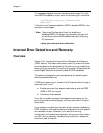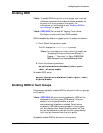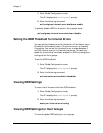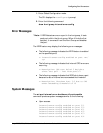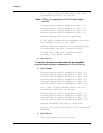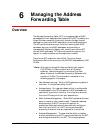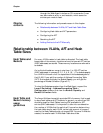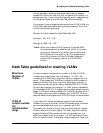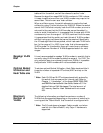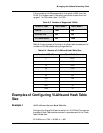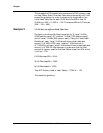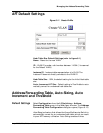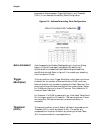
6-2 Avaya P550R, P580, P880, and P882 Multiservice Switch User Guide, Version v5.3.1
Chapter
through the Web Agent interface or CLI commands. A user
can also make an entry or entries static, which saves the
entries upon module reset.
Chapter
contents
The following information and procedures are in this chapter.
■ Relationship between VLANs, AFT and Hash Table Sizes
■ Configuring Hash table and AFT parameters
■ Configuring the AFT
■ Searching the AFT
■ Adding Entries to the AFT Manually
Relationship between VLANs, AFT and Hash
Table Sizes
Hash Tables and
Buckets
For every VLAN created, a hash table is allocated. The hash table
keeps track of the memory locations where the learned AFT entries
(MAC addresses) are stored. These memory locations are referred to
as buckets.
An individual bucket can range in size from 1 to 128 AFT entries
(MAC addresses) in powers of 2 (1, 2, 4, 8, 16...). The bucket capacity
for a VLAN is the sum of all the capacities of the buckets assigned to
that VLAN. If you add the number of Address Forwarding Table
(AFT) Entries and divide by the Bucket Capacity, you will get the
percentage of Bucket Utilization (Figure 6-1).
To view the Bucket parameters from the Web Agent, expand the
Layer 2 Switching > Address Forwarding Table >
Configuration folders. And view the Bucket Capacity and
Bucket Utilization fields.
Hash Table and
Bucket memory
usage
guidelines
The Avaya Multiservice switch provides 60K of memory that is used
to store hash tables and AFT buckets. In general, no more then 20K
should be used for Hash Tables, leaving 40K available for AFT
entries (MAC addresses). It is important to take into consideration
the number of VLANs that the switch will have when determining
the hash table size for each VLAN, as the total amount of memory
used for the Hash Tables should not exceed 20K. As more VLANs are
created, the smaller each VLANs Hash Table should be.



